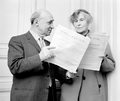Violin Concerto (Berg) facts for kids
Alban Berg's Violin Concerto was written in 1935. It is one of the most famous concertos for the violin from the 20th century. Many people think it is Berg's best-known and most often played piece of music.
Contents
How the Music Was Made
The composer Alban Berg was asked to write a violin concerto for a violinist named Louis Krasner. At the time, Berg was very busy working on his opera called Lulu. This opera took him several years to write!
He stopped working on Lulu for four months in the summer of 1935. This was so he could write the violin concerto. Berg had probably already started the concerto when he heard some sad news. A young girl named Manon Gropius had died. She was the daughter of Alma Mahler (who used to be Gustav Mahler's wife) and Walter Gropius.
Berg decided to dedicate the concerto to Manon. He wrote a special message at the top of the music: "To the memory of an angel." This shows how much he cared about her.
Berg himself died on 24 December 1935. He had not finished his opera Lulu. Some people think he might have finished it if he hadn't spent time writing the violin concerto. The Violin Concerto was first played after Berg's death. Louis Krasner, the violinist it was written for, played the solo part. This first performance happened on 19 April 1936 in Barcelona.
Instruments in the Orchestra
The orchestra for the Violin Concerto uses many different instruments. Here are some of them:
- 2 flutes (both also play piccolo)
- 2 oboes (one also plays cor anglais)
- alto saxophone (also plays clarinet)
- 2 clarinets
- bass clarinet
- 2 bassoons
- contrabassoon
- 4 horns
- 2 trumpets
- 2 trombones
- tuba
- timpani (kettledrums)
- percussion (other drums and instruments)
- harp
- piano
- strings (violins, violas, cellos, basses)
About the Music
The Violin Concerto has two main parts, called movements. Each movement is also split into two smaller sections.
- The first movement starts with a slow part called an Andante. It follows a classical sonata form. Then comes a faster, dance-like section called an Allegretto.
- The second movement begins with a very fast part called an Allegro. This part uses a small, repeating rhythm idea. The solo violin part here is very hard to play! The orchestra plays very loudly and builds up to a big, exciting moment. The music then ends quietly.
Berg wanted the first two sections of the concerto to represent life. The last two sections are meant to represent death.
Berg used a special way of composing music called the twelve-tone technique. He learned this from his teacher, Arnold Schoenberg. In twelve-tone music, all 12 different notes (like C, C sharp, D, etc.) must be used before any note can be repeated.
Even though Berg used the twelve-tone technique, his music sometimes sounds like it is in a normal major or minor key. This makes it easier for many people to listen to.
Here is the special order of notes, called a "tone row," that Berg used in this concerto:
This tone row doesn't sound as random as some other twelve-tone pieces. This is because parts of it sound like regular chords. For example:
- The first three notes (G, B flat, D) make a G minor chord.
- Notes three to five make a D major chord.
- Notes five to seven make an A minor chord.
- Notes seven to nine make an E major chord.
- The last four notes together sound like part of a whole-tone scale.
The first notes of each chord (G, D, A, E) are also the notes of the open strings on a violin! Berg made this very clear at the beginning of the concerto.
The last four notes of the tone row (which go up by whole steps) are also the first four notes of a famous church melody called Es ist genug (which means It Is Enough). Berg actually uses this old melody in the last part of the concerto. He even uses the same harmony (chords) that Johann Sebastian Bach wrote for it.
There is another special melody in the piece: a Carinthian folk song. It's quite unusual to hear a simple folk song in the middle of a big concerto! Berg included it because he wanted it to describe Manon Gropius, the young girl the concerto was dedicated to. He wanted to show her as a simple, innocent young girl.
Many people find twelve-tone music difficult to listen to. But this concerto is often easier to understand than other pieces that use this technique. This is partly because some of the music sounds more traditional. Also, the music tells a story or has a "programme" behind it. This story is about Manon, life, and death.
Images for kids
See also
 In Spanish: Concierto para violín (Berg) para niños
In Spanish: Concierto para violín (Berg) para niños



